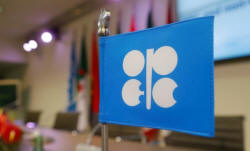|
OPEC sees smaller oil
glut in 2017 but flags U.S. shale recovery
 Send a link to a friend
Send a link to a friend
 [January 18, 2017]
By Alex Lawler [January 18, 2017]
By Alex Lawler
LONDON
(Reuters) - OPEC signaled a falling oil supply surplus in 2017 on
Wednesday as the exporter group's output slips from a record high ahead
of a deal to cut supply and outside producers show positive initial
signs of complying with the accord.
However, the Organization of the Petroleum Exporting Countries, in a
monthly report, also pointed to the possibly of a rebound in U.S.
output, as higher oil prices following supply cuts by other producers
support increased shale drilling.
OPEC and several independent producers agreed last year to cut supply,
the first such deal in 15 years, as of Jan. 1, 2017 to remove a glut.
The effort has helped oil prices to rise to $55 a barrel, from a 12-year
low near $27 a year ago.
"A continued normalization of monetary policies, indicating improving
economic conditions, together with the recent historic cooperation
between OPEC and non-OPEC producers, should help to bring needed
stability to the oil market," OPEC said.
"Initial reports show positive signs of compliance with pledged
production adjustments," OPEC added of non-members' contribution.

OPEC in November finalised a plan to cut its output by about 1.20
million bpd to 32.50 million bpd. Russia and other non-member countries
pledged curbs of around 560,000 bpd in December.
The OPEC figures published on Wednesday showed the biggest reduction
came from Saudi Arabia, which told OPEC it cut output to 10.47 million
bpd.
Losses in Nigeria, which is exempt from cutting output because its
production has been curbed by conflict, provided the second largest.
OPEC also cut its forecast of non-OPEC supply growth in 2017 to 120,000
bpd after the cut pledges by the independent producers, although this
was offset by a 230,000 bpd upward revision to U.S. supply.
[to top of second column] |

A flag with the Organization of the Petroleum Exporting Countries
(OPEC) logo is seen before a news conference at OPEC's headquarters
in Vienna, Austria December 10, 2016. REUTERS/Heinz-Peter Bader

"The main component of U.S. oil output – tight oil – is forecast to
grow," OPEC said, using another term for shale.
A renewed jump in U.S. supply, effectively subsidized by the voluntary
cuts elsewhere, could weigh on OPEC efforts to boost oil prices and
provide an echo of developments which lead up to the price crash
starting in mid-2014.
But OPEC leaders such as Saudi Energy Minister Khalid al Falih say they
don't expect a shale surge any time soon.
With demand for OPEC crude in 2017 expected to average 32.10 million
bpd, the report indicates there will be an average surplus of 985,000
bpd if OPEC keeps output steady. Last month's report pointed to a 1.24
million bpd surplus.
The OPEC report, in relocating Indonesian production of about 740,000
bpd into non-OPEC, also made OPEC output appear closer to the production
target which took effect on Jan 1.
Total OPEC output in December was just 585,000 bpd above the target,
compared to 1.37 million bpd in last month's report, thanks in large
part to Indonesia's departure from the group.
OPEC said, when the target was adopted, that it included Indonesia and
has not specified if the figure will be reduced to reflect the Asian
country's departure.
(editing by Susan Thomas andn David Evans)
[© 2017 Thomson Reuters. All rights
reserved.] Copyright 2017 Reuters. All rights reserved. This material may not be published,
broadcast, rewritten or redistributed.
 |